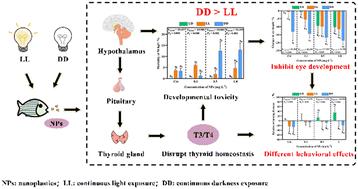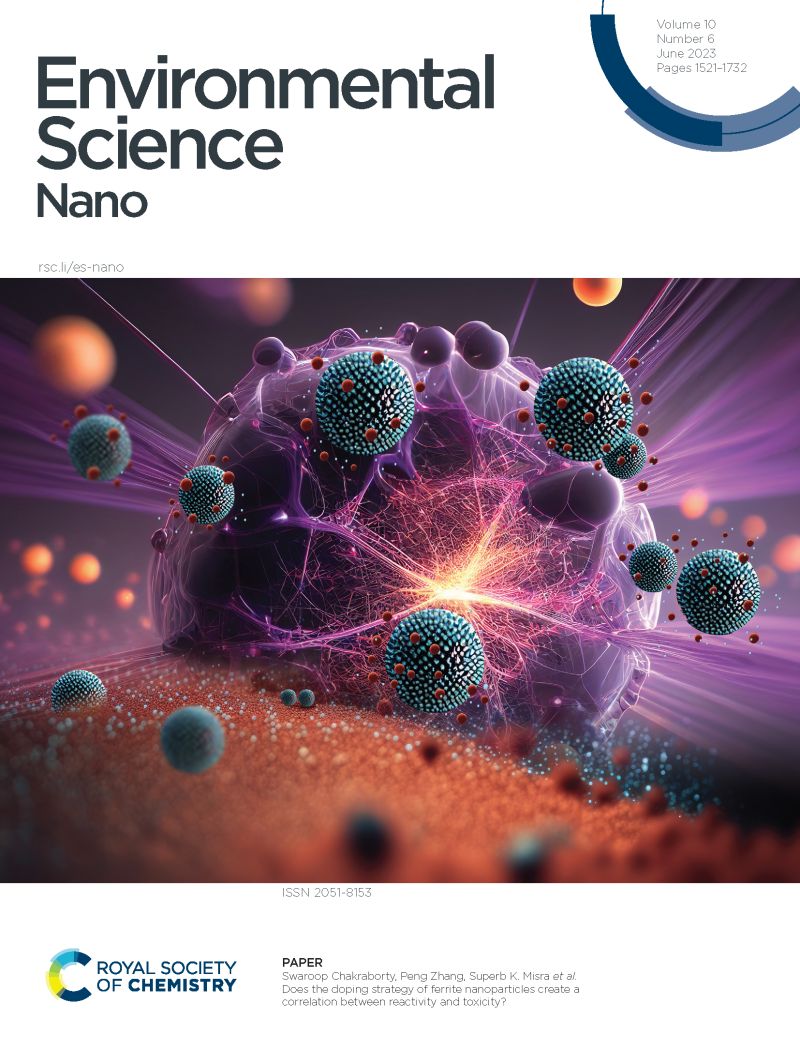Disruption of light–dark rhythms alters embryonic development toxicity and neurotoxicity of nanoplastics on zebrafish larvae by regulating thyroid pathways
IF 5.1
2区 环境科学与生态学
Q1 CHEMISTRY, MULTIDISCIPLINARY
引用次数: 0
Abstract
Disruption of light–dark rhythms may increase the susceptibility of organisms to contaminants. Herein, the toxicities and related mechanisms of nanoplastics (NPs) under different light–dark rhythms were investigated. Zebrafish embryos exposed to polystyrene NPs (PS-NH2 NPs; 50 nm) within environmentally relevant concentrations caused deformities (small eyes, pericardial edema, and spinal curvature) and increased swimming distances in zebrafish larvae. Both continuous light (LL) and continuous darkness (DD) increased the developmental toxicity of nanoplastics in zebrafish embryos, with DD having the stronger effect. The reason was that DD conditions down-regulated the pathways of thyroid, visual development, and cytochrome P450, as NP exposure did, whereas LL conditions down-regulated the first two pathways but up-regulated the cytochrome P450 pathway, which has detoxification effects in organisms. However, LL and DD conditions decreased the swimming distances of NP-treated larvae because they promoted the inhibition effect on eye development and elevated T4 levels in zebrafish larvae. Regulation of light–dark rhythms dominated the swimming behavior of zebrafish larvae under combined exposure. Our findings suggest that the influence of environmental factors on the potential health risks of NPs cannot be ignored.

光暗节律的破坏通过调节甲状腺通路改变纳米塑料对斑马鱼幼体的胚胎发育毒性和神经毒性
昼夜节律的中断可能会增加生物体对污染物的敏感性。本文研究了纳米塑料(NPs)在不同光暗节律下的毒性及其相关机制。斑马鱼胚胎暴露在环境相关浓度的聚苯乙烯NPs (PS-NH2 NPs; 50 nm)中会导致斑马鱼幼鱼畸形(小眼睛、心包水肿和脊柱弯曲)和游泳距离增加。连续光照(LL)和连续黑暗(DD)均增加了纳米塑料对斑马鱼胚胎的发育毒性,其中DD的作用更强。原因是DD条件下调了甲状腺、视觉发育和细胞色素P450通路,与NP暴露一样,而LL条件下调了前两个通路,但上调了细胞色素P450通路,这在生物体中具有解毒作用。然而,LL和DD条件减少了np处理的斑马鱼幼虫的游泳距离,这是因为它们促进了对眼睛发育的抑制作用,提高了T4水平。混合暴露条件下斑马鱼幼鱼的游泳行为受光暗节律调控的支配。我们的研究结果表明,环境因素对NPs潜在健康风险的影响不容忽视。
本文章由计算机程序翻译,如有差异,请以英文原文为准。
求助全文
约1分钟内获得全文
求助全文
来源期刊

Environmental Science: Nano
CHEMISTRY, MULTIDISCIPLINARY-ENVIRONMENTAL SCIENCES
CiteScore
12.20
自引率
5.50%
发文量
290
审稿时长
2.1 months
期刊介绍:
Environmental Science: Nano serves as a comprehensive and high-impact peer-reviewed source of information on the design and demonstration of engineered nanomaterials for environment-based applications. It also covers the interactions between engineered, natural, and incidental nanomaterials with biological and environmental systems. This scope includes, but is not limited to, the following topic areas:
Novel nanomaterial-based applications for water, air, soil, food, and energy sustainability
Nanomaterial interactions with biological systems and nanotoxicology
Environmental fate, reactivity, and transformations of nanoscale materials
Nanoscale processes in the environment
Sustainable nanotechnology including rational nanomaterial design, life cycle assessment, risk/benefit analysis
 求助内容:
求助内容: 应助结果提醒方式:
应助结果提醒方式:


